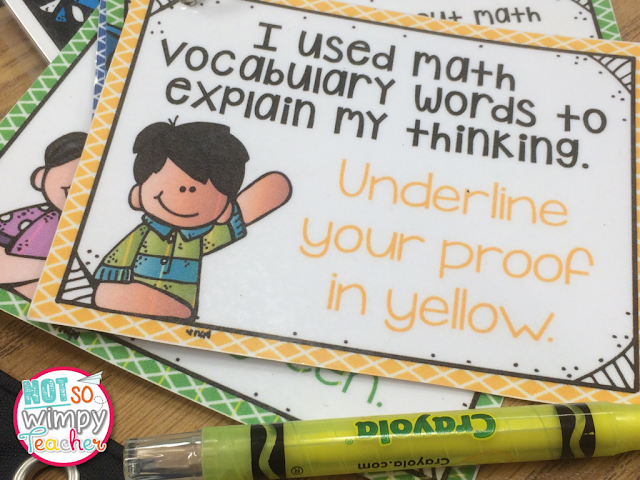Now, more than ever, a student's success in math is very closely tied to their mathematical vocabulary. Having a good working math vocabulary will help students to understand directions, find key words in word problems and increase their overall scores on high stakes testing. All of that is great... but I teach math vocabulary primarily because it makes my students feel more like mathematicians. It raises their overall confidence and motivation! Teaching math vocabulary is more than just telling students what a word means and having them write the definition in a journal. Here are some tips for creating a vocabulary rich math classroom that is engaging and meaninful.
1. Constant Use with Meaning or Synonym
The simplest way to teach math vocabulary is to constantly use the new words in conjunction with words that they already know. For example, I will ask my students, "What is the product or the answer?" Or, "Write an equation or number sentence that can be used to solve." I talk like this ALL the time when teaching my math lessons. It is easy to get in the habit of talking down to your students and avoiding the math vocabulary. I am trying to teach some tough math concepts and so I don't want to have confusing directions. But, we have to use these words as much as possible. Their success in math depends heavily on their ability to understand and use math vocabulary. Students are hearing the words over and over, but are given context to understand. It is not long before they sound just like you!
(Please ignore my 2nd chin! When an eight year old is the photographer- they rarely get the best angle!)
2. Pair Share
Students need to be given specific times to orally practice their math vocabulary. I use pair shares and teach-okay (a Whole Brain Teaching strategy) to get my kids talking ALL the time. When I introduce a brand new math vocabulary word, I will ask students to teach the meaning right back to their partner. Throughout our math lessons, I ask my students to teach their problem solving strategy to their partner. I reward and compliment students who use our math vocabulary. The bigger deal I make out of it, the more vocabulary I will hear during our next strategy share.
3. Math Vocabulary Wall
It is important to dedicate some space in your classroom for displaying current math vocabulary words. The definitions MUST be in simple student-friendly language. I think that they are even more effective if they have a picture that helps your visual learners to understand the definition. I keep my words down low so that my students can reach them. They are encouraged to use them during centers. I display the words that correlate with our current unit, but keep the others where they are accessible for spiral review activities throughout the year. I think that this helps to keep students focused on the most current vocabulary while still providing access to previously learned words.
You can read more about my vocabulary display and cards by clicking HERE.
4. Provide Opportunities to Write About Math
I love to hear students using math vocabulary with their partner, but I also want to provide opportunities for students to use the new words in their writing. I think that it helps to cement their learning and provides opportunities for me to assess their understanding. During math centers, my students are given math journal prompts that ask them to explain their thinking. This is an excellent time to show off their new mathematical vocabulary! I encourage them to do this by asking them to color code various components of their answer. The math vocabulary is underlined in yellow. If they don't have anything to underline, they know they need to go back and revise.
I am really proud of how much thought goes in to their responses. This little gal might struggle with her spelling, but she is correctly using some awesome vocabulary words to explain her strategy!
This math journal question is part of my Multiplication Centers, but I also have a Third Grade Math Journal that has prompts for every standard! They pair perfectly with my Prove It With Color cards.








No comments:
Post a Comment